Browse all traits
We test for 55 traits. Learn what makes your dog unique, from the shape of their nose to the tips of their toes.
Browse other features
Altitude Adaptation
This gene causes dogs to be especially tolerant of low-oxygen environments, such as those found at high elevations.
Performance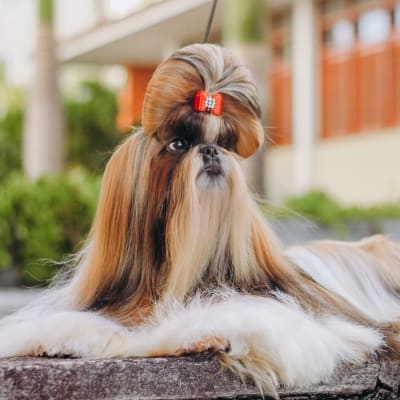
Gene: EPAS1
This gene causes dogs to be especially tolerant of low oxygen environments, such as those found at high elevations. Dogs with a AA or GA result will be less susceptible to "altitude sickness."
Did you know? This gene was originally identified in breeds from high altitude areas such as the Tibetan Mastiff.
Appetite
This gene influences food motivation and eating behavior.
Performance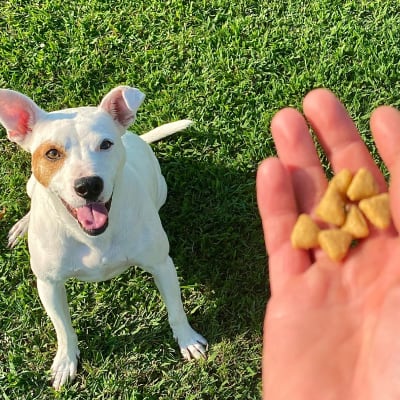
Gene: POMC
This gene influences eating behavior. An ND or DD result would predict higher food motivation compared to NN result, increasing the likelihood to eat excessively, have higher body fat percentage, and be more prone to obesity. Read more about the genetics of POMC, and learn how you can contribute to research, in our blog post. We measure this result using a linkage test.
Did you know? POMC is actually short for "proopiomelanocortin," and is a large protein that is broken up into several smaller proteins that have biological activity. The smaller proteins generated from POMC control, among other things, distribution of pigment to the hair and skin cells, appetite, and energy expenditure.
Back Muscling & Bulk (Large Breed)
This gene can cause heavy muscling along the back and trunk in large-breed dogs.
Other Body Features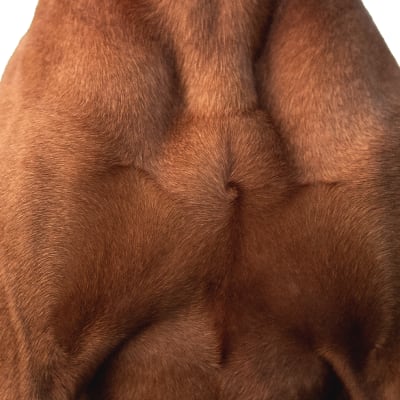
Gene: ACSL4
This gene can cause heavy muscling along the back and trunk in characteristically "bulky" large-breed dogs including the Saint Bernard, Bernese Mountain Dog, Greater Swiss Mountain Dog, and Rottweiler. A dog with the TT result is likely to have heavy muscling. Leaner-shaped large breed dogs like the Great Dane, Irish Wolfhound, and Scottish Deerhound generally have a CC result. The TC result also indicates likely normal muscling.
Did you know? This gene does not seem to affect muscling in small or even mid-sized dog breeds with lots of back muscling, including the American Staffordshire Terrier, Boston Terrier, and the English Bulldog.
Body Pattern
This gene is responsible for causing different coat patterns.
Coat Color Modifiers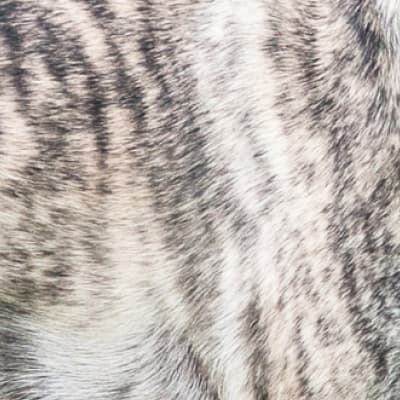
Gene: Agouti Signalling Protein (ASIP)
This gene is responsible for causing different coat patterns. It only affects the fur of dogs that do not have ee at the E (Extension) Locus and do have kyky at the K (Dominant Black) Locus. It controls switching between black and red pigment in hair cells, which means that it can cause a dog to have hairs that have sections of black and sections of red/cream, or hairs with different colors on different parts of the dog’s body. Sable or Fawn dogs have a mostly or entirely red coat with some interspersed black hairs. Agouti or Wolf Sable dogs have red hairs with black tips, mostly on their head and back. Black and tan dogs are mostly black or brown with lighter patches on their cheeks, eyebrows, chest, and legs. Recessive black dogs have solid-colored black or brown coats.
Did you know? The ASIP gene causes interesting coat patterns in many other species of animals as well as dogs.
Body Size 1
One of the genes that influence the size of a dog.
Body SizeGene: IGF1
This is one of several genes that influence the size of a dog. A result of II for this gene is associated with smaller body size. A result of NN is associated with larger body size.
Body Size 2
One of the genes that influence the size of a dog.
Body SizeGene: IGFR1
This is one of several genes that influence the size of a dog. A result of AA for this gene is associated with smaller body size. A result of GG is associated with larger body size.
Body Size 3
One of the genes that influence the size of a dog.
Body SizeGene: STC2
This is one of several genes that influence the size of a dog. A result of AA for this gene is associated with smaller body size. A result of TT is associated with larger body size.
Body Size 4
One of the genes that influence the size of a dog.
Body SizeGene: GHR - E191K
This is one of several genes that influence the size of a dog. A result of AA for this gene is associated with smaller body size. A result of GG is associated with larger body size.
Body Size 5
One of the genes that influence the size of a dog.
Body SizeGene: GHR - P177L
This is one of several genes that influence the size of a dog. A result of TT for this gene is associated with smaller body size. A result of CC is associated with larger body size.
Brown or Black Pigment
This gene determines whether a dog produces brown or black pigments.
Base Coat Color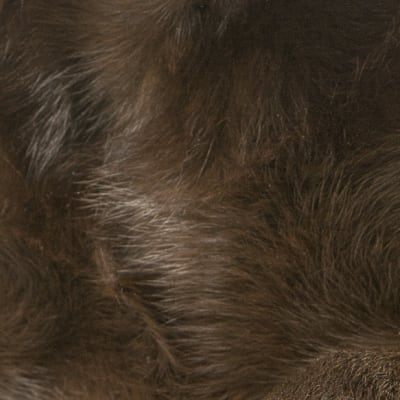
Gene: Tyrosinase Related Protein 1 (TYRP1)
This gene helps determine whether a dog produces brown or black pigments. Dogs with a bb result produce brown pigment instead of black in both their hair and skin, while dogs with a Bb or BB result produce black pigment. Dogs that have ee at the E (Extension) Locus and bb at this B (Brown) Locus are likely to have red or cream coats and brown noses, eye rims, and footpads, which is sometimes referred to as "Dudley Nose" in Labrador Retrievers.
Did you know? “Liver” or “chocolate” is the preferred color term for brown in most breeds; in the Doberman Pinscher it is referred to as “red”.
Chondrodysplasia (Leg Length)
not set
Other Body FeaturesGene: Chr. 18 FGF4 Retrogene
This variant is associated with a type of disproportionate dwarfism known as chondrodysplasia (CDPA). CDPA is a breed-defining characteristic of many breeds exhibiting a “short-legged, long-bodied” appearance, such as Corgis, Dachshunds, Basset Hounds, and others. Dogs with the II result display the largest reduction in leg length. Dogs with the NI genotype will have an intermediate leg length, while dogs with the NN result will not exhibit leg shortening due to this variant.
Did you know? A similar genetic variant called the chondrodystrophy (CDDY) variant also plays an important role in shortening the leg length of many breeds. Dog breeds with the shortest legs, like the Corgi, Dachshund, and Basset Hound generally have one or two copies of the CDDY and CDPA variants. CDDY (but not CDPA) is also associated with an increased risk of Type I Intervertebral Disc Disease (IVDD). You can see the CDDY result in the health test results under “Intervertebral Disc Disease Type I".
Coat Length
This gene affects hair length in many different species, including dogs, cats, mice, and humans.
Other Coat Traits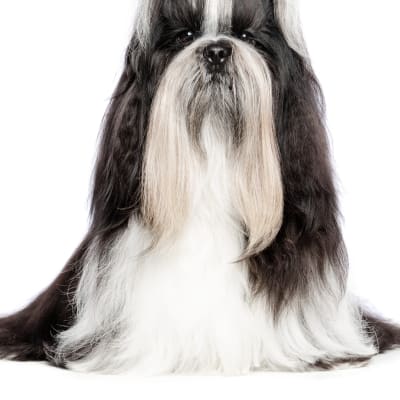
Gene: FGF5
This gene affects hair length in many species, including cats, dogs, mice, and humans. In dogs, an Lh allele confers a long, silky hair coat across many breeds, including Yorkshire Terriers, Cocker Spaniels, and Golden Retrievers. An ShSh or ShLh result is likely to mean a shorter coat, like in the Boxer or the American Staffordshire Terrier. The coat length determined by FGF5, as reported by us, is influenced by four genetic variants that work together to promote long hair.
The most common of these is the Lh1 variant (G/T, CanFam3.1, chr32, g.4509367) and the less common ones are Lh2 (C/T, CanFam3.1, chr32, g.4528639), Lh3 (16bp deletion, CanFam3.1, chr32, g.4528616), and Lh4 (GG insertion, CanFam3.1, chr32, g.4528621). The FGF5_Lh1 variant is found across many dog breeds. The less common variants, FGF5_Lh2 have been found in the Akita, Samoyed, and Siberian Husky, FGF5_Lh3 have been found in the Eurasier, and FGF5_Lh4 have been found in the Afghan Hound, Eurasier, and French Bulldog.
The Lh alleles have a recessive mode of inheritance, meaning that two copies of the Lh alleles are required to have long hair. The presence of two Lh alleles at any of these FGF5 loci is expected to result in long hair. One copy each of Lh1 and Lh2 have been found in Samoyeds, one copy each of Lh1 and Lh3 have been found in Eurasiers and one copy each of Lh1 and Lh4 have been found in Afghan Hounds and Eurasiers.
Did you know? In certain breeds, such as Pembroke Welsh Corgi and French Bulldog, the long coat is described as “fluffy.”
Coat Texture
This gene contributes to whether a dog’s coat is curly, wavy, or straight.
Other Coat Traits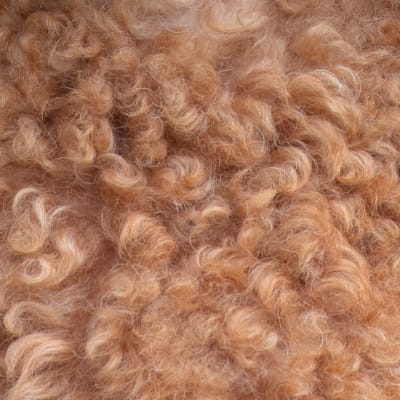
Gene: KRT71
For dogs with long fur, dogs with a TT or CT result will likely have a wavy or curly coat like the coat of Poodles and Bichon Frises. Dogs with a CC result will likely have a straight coat—unless the dog has a "Likely Furnished" result for the Furnishings trait, since this can also make the coat more curly.
Did you know? Dogs with short coats may have straight coats, whatever result they have for this gene.
Color Dilution
This gene determines whether a dog has lighter “diluted” pigment.
Base Coat Color
Gene: Melanophilin (MLPH)
This gene helps determine whether a dog has lighter “diluted” pigment. A dog with a Dd or DD result will not be dilute. A dog with a dd result will have all their black or brown pigment lightened (“diluted”) to gray or light brown, and may lighten red pigment to cream. This affects their fur, skin, and sometimes eye color. The D locus result that we report is determined by three different genetic variants that can work together to cause diluted pigmentation. These are the common d allele, also known as “d1”, and the less common alleles known as “d2” and “d3”. Dogs with two d alleles, regardless of which variant, are typically dilute.
Did you know? There are many breed-specific names for these dilute colors, such as “blue”, “charcoal”, “fawn”, “silver”, and “Isabella”. Dilute dogs, especially in certain breeds, have a higher incidence of Color Dilution Alopecia which causes hair loss in some patches.
Dark brown pigment
This gene determines if a dog produces dark brown pigment instead of black in both their hair and skin.
Base Coat Color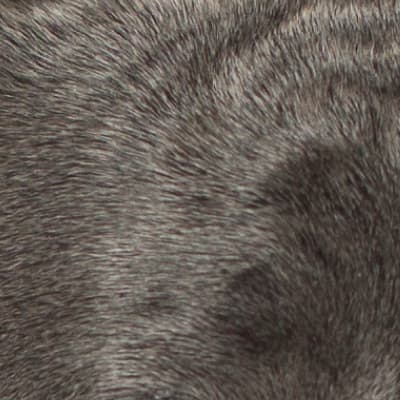
Gene: HPS3
Dogs with the coco genotype will produce dark brown pigment instead of black in both their hair and skin. Dogs with the Nco genotype will produce black pigment, but can pass the co variant on to their puppies. Dogs that have the coco genotype as well as the bb genotype at the B locus are generally a lighter brown than dogs that have the Bb or BB genotypes at the B locus.
Did you know? The co variant and the dark brown "cocoa" coat color have only been documented in French Bulldogs. Dogs with the cocoa coat color are sometimes born with light brown coats that darken as they reach maturity.
Dark or Light Fur
This gene determines if a dog can produce dark hairs and can give a dog a black “mask” or “widow’s peak.”
Base Coat Color
Gene: Melanocortin Receptor 1 (MC1R)
This gene helps determine whether a dog can produce dark (black or brown) hairs or lighter yellow or red hairs. Any result except for ee means that the dog can produce dark hairs. An ee result means that the dog does not produce dark hairs and will have lighter yellow or red hairs all over its entire body.
The overall MC1R genetic result is influenced by more subloci than those presented in this section. Additional MC1R subloci results can be found under the Coat Color Modifiers > Facial Fur Pattern section below.
Did you know? If a dog has an ee result, then the fur’s actual shade can range from a deep copper to white - the exact color cannot be predicted solely from this result and will depend on other genetic factors, including the red pigment intensity test.
Eye Color
This gene is associated with blue eyes in dogs.
Other Body Features
Gene: ALX4
This gene is associated with blue eyes in Arctic breeds like Siberian Husky as well as tri-colored (non-merle) Australian Shepherds. Dogs with a DupDup or NDup result are more likely to have blue eyes, although some dogs may have only one blue eye or may not have blue eyes at all; nevertheless, they can still pass blue eyes to their offspring. Dogs with a NN result may have blue eyes due to other factors, such as merle or white spotting. We measure this result using a linkage test.
Did you know? Embark researchers discovered this gene by studying data from dogs like yours. Who knows what we will be able to discover next? Answer the questions on our research surveys to contribute to future discoveries!
Facial Fur Pattern
This gene determines if a dog can produce dark hairs and can give a dog a black “mask” or “widow’s peak.”
Coat Color Modifiers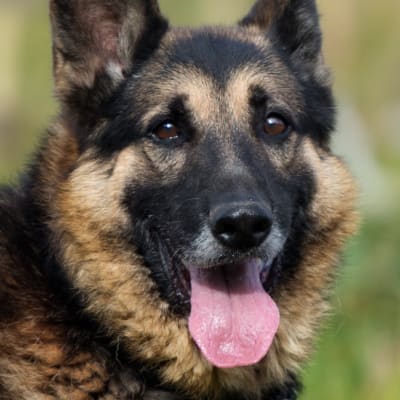
Gene: Melanocortin Receptor 1 (MC1R)
This gene determines whether a dog can have dark hair and can give it a black “mask” or “widow’s peak,” unless the dog has overriding coat color genetic factors. Dogs with one or two copies of Em in their result may have a mask, which is dark facial fur as seen in the German Shepherd Dog and Pug. Dogs with no Em in their result but one or two copies of the Eg, Ea, or Eh variants can instead have a "widow's peak", which is dark forehead fur.
Did you know?
The "widow’s peak" is seen in the Afghan Hound and Borzoi, and is called either “grizzle” or “domino.”
In the absence of Em, dogs with the Eg variant can have a “widow’s peak” phenotype. In the absence of both Em and E variants, dogs with the Ea or Eh variants can express the “widow’s peak” phenotype. Additionally, a dog with any combination of two of the Eg, Ea, or Eh variants (example: EgEa) is also expected to express the grizzle phenotype.
Furnishings
This gene is responsible for the mustache, beard, and eyebrows characteristic of some breeds.
Other Coat Traits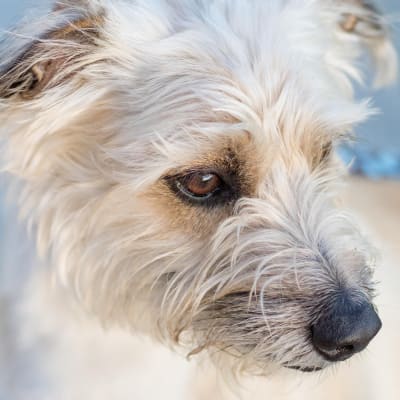
Gene: RSPO2
This gene is responsible for “furnishings”, which is another name for the mustache, beard, and eyebrows that are characteristic of breeds like the Schnauzer, Scottish Terrier, and Wire Haired Dachshund. A dog with an FF or FI result is likely to have furnishings. A dog with an II result will not have furnishings. We measure this result using a linkage test.
Did you know? In breeds that are expected to have furnishings, dogs without furnishings are the exception - this is sometimes called an “improper coat”.
Hairlessness (Terrier type)
This gene is responsible for hairlessness in the American Hairless Terrier.
Other Coat Traits
Gene: SGK3
This gene is responsible for Hairlessness in the American Hairless Terrier. Dogs with the DD result are likely to be hairless. Dogs with the ND genotype will have a normal coat, but can pass the D variant on to their offspring.
Hairlessness (Xolo type)
This gene can cause hairlessness over most of the body and affect tooth shape and number.
Other Coat Traits
Gene: FOXI3
This gene can cause hairlessness over most of the body as well as changes in tooth shape and number. This particular gene occurs in Peruvian Inca Orchid, Xoloitzcuintli (Mexican Hairless), and Chinese Crested; other hairless breeds are due to different genes. Dogs with the NDup result are likely to be hairless while dogs with the NN result are likely to have a normal coat. We measure this result using a linkage test.
Did you know? The DupDup result has never been observed, suggesting that dogs with that genotype cannot survive to birth.
Harlequin
This gene determines whether a dog will have harlequin patterning, or a white coat with patches of darker pigment.
Coat Color Modifiers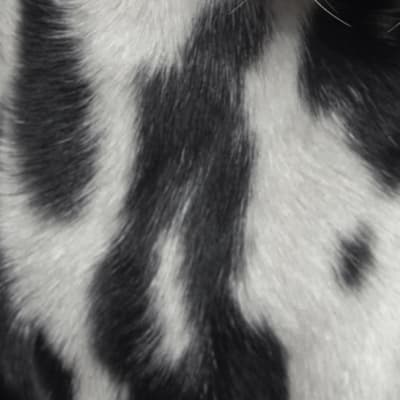
Gene: PSMB
This gene, along with the M Locus, determines whether a dog will have harlequin patterning. This pattern is recognized in Great Danes and causes dogs to have a white coat with patches of darker pigment. A dog with an Hh result will be harlequin if they are also M*m or M*M* at the M Locus and are not ee at the E locus. Dogs with a result of hh will not be harlequin.
Did you know? While many harlequin dogs are white with black patches, some dogs have grey, sable, or brindle patches of color, depending on their genotypes at other coat color genes.
Hidden Patterning
This gene helps determine whether a dog has a black coat.
Coat Color Modifiers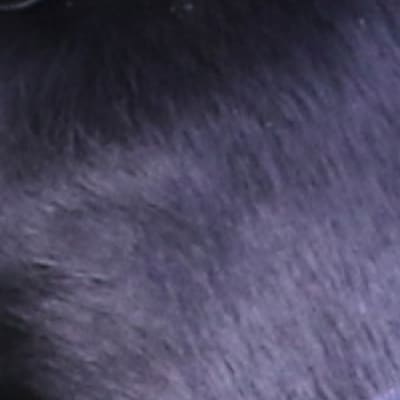
Hind Dew Claws
This gene can result in extra, nonfunctional digits located midway between a dog's paw and ankle.
Other Body Features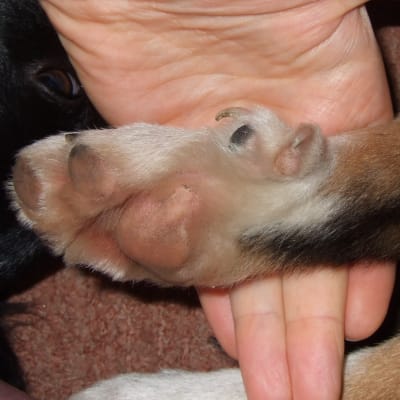
Gene: LMBR1
This is one of the genes that can cause hind dew claws, which are extra, nonfunctional digits located midway between a dog's paw and hock. Dogs with a CT or TT result have about a 50% chance of having hind dewclaws. Hind dew claws can also be caused by other, still unknown, genes. Embark is working to figure those out.
Did you know? Hind dew claws are commonly found in certain breeds such as the Saint Bernard.
Immune Response 1
This gene is related to diversity in the Major Histocompatibility Complex (MHC II).
Genetic DiversityGene: DRB1
Diversity in the Major Histocompatibility Complex (MHC) region of the genome has been found in some studies to be associated with the incidence of certain autoimmune diseases. Dogs that have less diversity in the MHC region—i.e. the Dog Leukocyte Antigen (DLA) inherited from the mother is similar to the DLA inherited from the father—are considered less immunologically diverse. A High Diversity result means the dog has two highly dissimilar haplotypes. A Low Diversity result means the dog has two similar but not identical haplotypes. A No Diversity result means the dog has inherited identical haplotypes from both parents. Some studies have shown associations between certain DRB1 haplotypes and autoimmune diseases such as Cushing's disease, but these findings have yet to be scientifically validated.
Immune Response 2
These genes are related to diversity in the Major Histocompatibility Complex (MHC II).
Genetic DiversityGene: DQA1 and DQB1
Diversity in the Major Histocompatibility Complex (MHC) region of the genome has been found in some studies to be associated with the incidence of certain autoimmune diseases. Dogs that have less diversity in the MHC region—i.e. the Dog Leukocyte Antigen (DLA) inherited from the mother is similar to the DLA inherited from the father—are considered less immunologically diverse. A High Diversity result means the dog has two highly dissimilar haplotypes. A Low Diversity result means the dog has two similar but not identical haplotypes. A No Diversity result means the dog has inherited identical haplotypes from both parents. A number of studies have shown correlations of DQA-DQB1 haplotypes and certain autoimmune diseases; however, these have not yet been scientifically validated.
Inbreeding
Our genetic COI measures how closely related a dog’s parents were.
Genetic DiversityGene: n/a
Inbreeding is a measure of how closely related this dog’s parents were. The higher the number, the more closely related the parents. In general, greater inbreeding is associated with increased incidence of genetically inherited conditions.
Merle
This gene is responsible for a mottled or patchy coat color in some dogs.
Coat Color Modifiers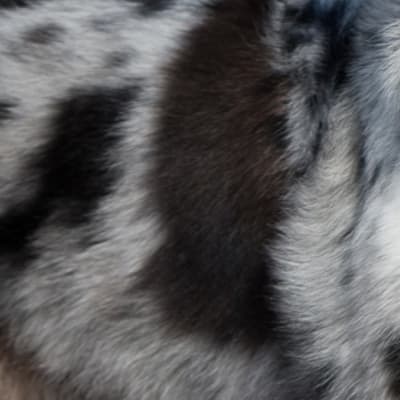
Gene: PMEL
This gene is responsible for mottled or patchy coat color in some dogs. Dogs with an M*m result are likely to appear merle or could be "non-expressing" merle, meaning that the merle pattern is very subtle or not at all evident in their coat. Dogs with an M*M* result are likely to have merle or double merle coat patterning. Dogs with an mm result are unlikely to have a merle coat pattern.
Did you know? Merle coat patterning is common to several dog breeds including the Australian Shepherd, Catahoula Leopard Dog, and Shetland Sheepdog.
Muzzle Length
This gene affects muzzle length.
Other Body Features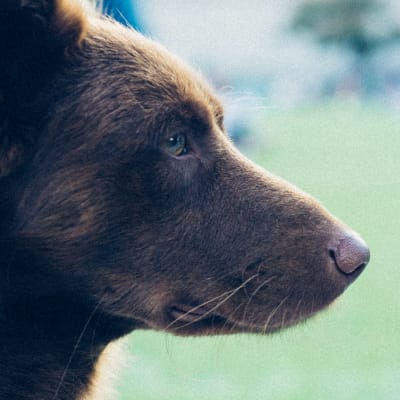
Gene: BMP3
This gene affects muzzle length. A dog with a AC or CC result is likely to have a medium-length muzzle like a Staffordshire Terrier or Labrador, or a long muzzle like a Whippet or Collie. A dog with a AA result is likely to have a short muzzle, like an English Bulldog, Pug, or Pekingese.
Did you know? At least five different genes affect snout length in dogs, with BMP3 being the only one with a known causal mutation. For example, the muzzle length of some breeds, including the long-snouted Scottish Terrier or the short-snouted Japanese Chin, appear to be caused by other genes. This means your dog may have a long or short snout due to other genetic factors. Embark is working to figure out what these might be.
Oculocutaneous Albinism Type 2
This gene can cause severely reduced or absent pigment in the eyes, skin, and hair.
Other Coat TraitsGene: SLC45A2
This gene causes oculocutaneous albinism (OCA), also known as Doberman Z Factor Albinism. Dogs with a DD result will have OCA. Effects include severely reduced or absent pigment in the eyes, skin, and hair, and sometimes vision problems due to lack of eye pigment (which helps direct and absorb ambient light) and are prone to sunburn. Dogs with a ND result will not be affected, but can pass the mutation on to their offspring. We measure this result using a linkage test.
Did you know? This particular mutation can be traced back to a single white Doberman Pinscher born in 1976, and it has only been observed in dogs descended from this individual.
Panda White Spotting
not set
Coat Color ModifiersGene: KIT
Panda White Spotting originated in a line of German Shepherd Dogs and causes a mostly symmetrical white spotting of the head and/or body. This is a dominant variant of the KIT gene, which has a role in pigmentation.
Dogs with one copy of the I allele will exhibit this white spotting. Dogs with two copies of the I allele have never been observed, as two copies of the variant is suspected to be lethal to the developing embryo. Dogs with the NN result will not exhibit white spotting due to this variant.
Did you know? A de novo mutation (a genetic mutation not inherited from the parents) occurred in a female German Shepherd Dog named Lewcinka's Franka von Phenom. She was born in 2000, and all Panda Shepherds can trace their bloodline back to her.
Red Pigment Intensity
These loci influence the concentration of red pigment in a dog’s coat.
Base Coat Color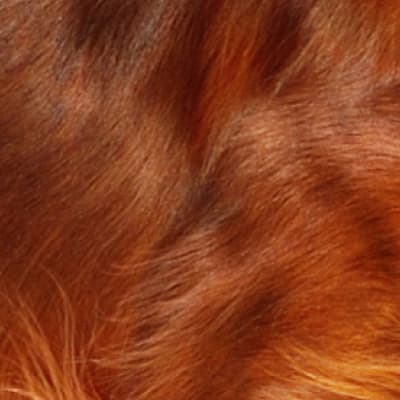
Gene:
Intensity refers to the concentration of red pigment in the coat. Dogs with more densely concentrated (intense) pigment will be a deeper red, while dogs with less concentrated (dilute) pigment will be tan, yellow, cream, or white. Five locations in the dog genome explain approximately 70% of red pigmentation intensity variation across all dogs. Because the locations we test may not directly cause differences in red pigmentation intensity, we consider this to be a linkage test.
Did you know? One of the genes that influences pigment intensity in dogs, TYR, is also responsible for intensity variation in domestic mice, cats, cattle, rabbits, and llamas. In dogs and humans, more genes are involved.
Roan
This gene, along with the S Locus, regulates whether a dog will have roaning.
Coat Color Modifiers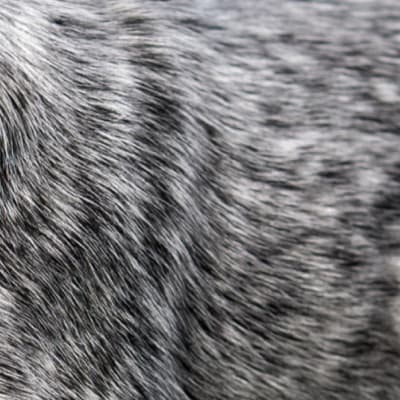
Gene: USH2A
This gene, along with the S Locus, regulates whether a dog will have roaning. Dogs with at least one copy of R will likely have roaning on otherwise uniformly unpigmented white areas created by the S Locus. Roan may not be visible if white spotting is limited to small areas, such as the paws, chest, face, or tail. The extent of roaning varies from uniform roaning to non-uniform roaning, and patchy, non-uniform roaning may look similar to ticking. Roan does not appear in white areas created by other genes, such as a combination of the E Locus and I Locus (for example, Samoyeds). The roan pattern can appear with or without ticking.
Did you know? Roan, tick, and Dalmatians' spots become visible a few weeks after birth. The R Locus is probably involved in the development of Dalmatians' spots.
Saddle Tan
This gene causes the black hairs to recede into a "saddle" shape on a dog’s back.
Coat Color Modifiers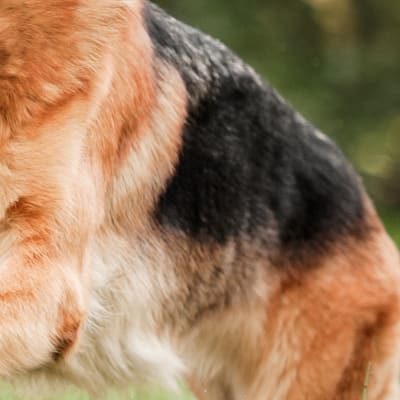
Gene: RALY
The "Saddle Tan" pattern causes the black hairs to recede into a "saddle" shape on the back, leaving a tan face, legs, and belly, as a dog ages. The Saddle Tan pattern is characteristic of breeds like the Corgi, Beagle, and German Shepherd. Dogs that have the II genotype at this locus are more likely to be mostly black with tan points on the eyebrows, muzzle, and legs as commonly seen in the Doberman Pinscher and the Rottweiler. This gene modifies the A Locus at allele, so dogs that do not express at are not influenced by this gene.
Did you know? The Saddle Tan pattern is characteristic of breeds like the Corgi, Beagle, and German Shepherd.
Shedding
This gene affects how much a dog sheds.
Other Coat Traits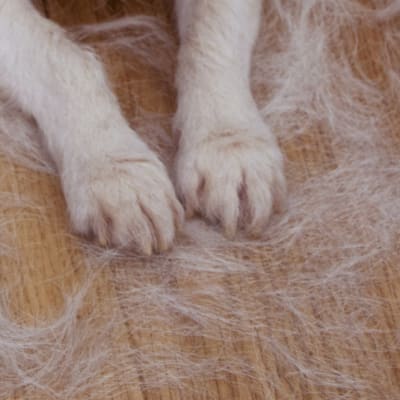
Gene: MC5R
This gene affects how much a dog sheds. Dogs with furnishings or wire-haired coats tend to be low shedders regardless of their result for this gene. In other dogs, a CC or CT result indicates heavy or seasonal shedding, like many Labradors and German Shepherd Dogs. Dogs with a TT result tend to be lighter shedders, like Boxers, Shih Tzus and Chihuahuas.
Tail Length
This gene can cause a short bobtail.
Other Body Features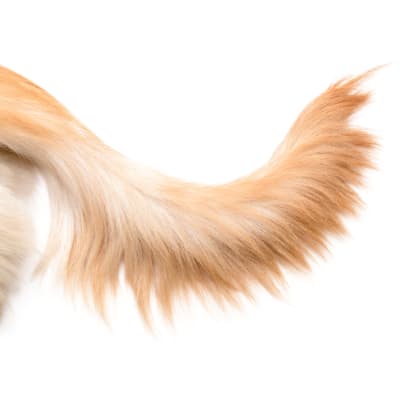
Gene: T
This is one of the genes that can cause a short bobtail. Most dogs have a CC result and a long tail. Dogs with a CG result are likely to have a bobtail, which is an unusually short or absent tail. This can be seen in many “natural bobtail” breeds including the Pembroke Welsh Corgi, the Australian Shepherd, and the Brittany Spaniel. Dogs with GG genotypes have not been observed, suggesting that dogs with such a result do not survive to birth.
Did you know? While certain lineages of Boston Terrier, English Bulldog, Rottweiler, Miniature Schnauzer, Cavalier King Charles Spaniel, and Parson Russell Terrier, and Dobermans are born with a natural bobtail, it is not always caused by this gene. This suggests that other unknown genetic effects can also lead to a natural bobtail.
White Spotting
This gene is responsible for most of the white spotting observed in dogs.
Coat Color Modifiers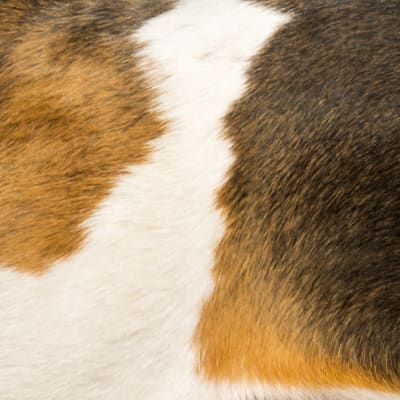
Gene: MITF
This gene is responsible for most of the white spotting observed in dogs. Dogs with a result of spsp will have a nearly white coat or large patches of white in their coat. Dogs with a result of Ssp will have more limited white spotting that is breed-dependent. A result of SS means that a dog likely has no white or minimal white in their coat. The S Locus does not explain all white spotting patterns in dogs and other causes are currently being researched. Some dogs may have small amounts of white on the paws, chest, face, or tail regardless of their result at this gene.
Did you know? Any dog can have white spotting regardless of coat color. The colored sections of the coat will reflect the dog’s other genetic coat color results.
Learn more about traits
Dog owners
Breed identification, health and trait insights, personalized care recommendations, and the world’s first canine relative finder—all in one leading dog DNA test.
Learn about the traits report for dog ownersShop the test
Breeding programs
Embark’s test for breeding programs is one comprehensive DNA test designed with your needs in mind.
Learn about the traits report for breedersShop the test




